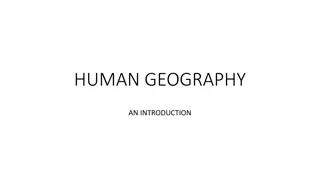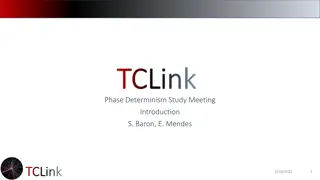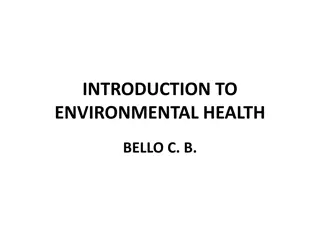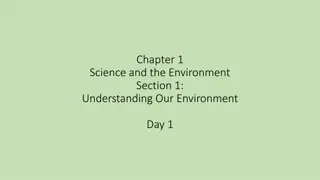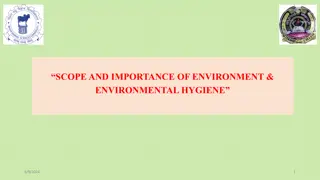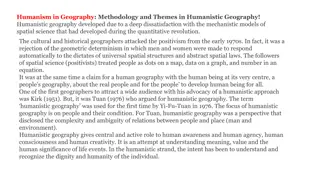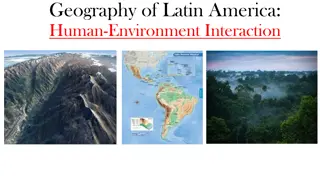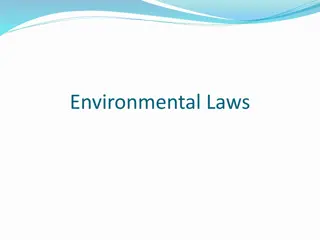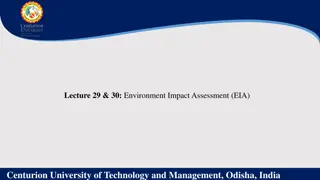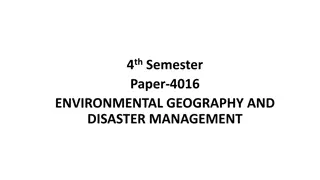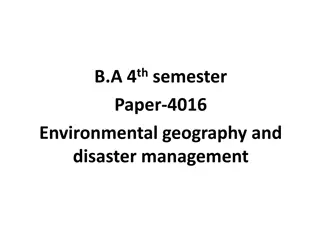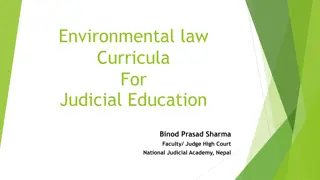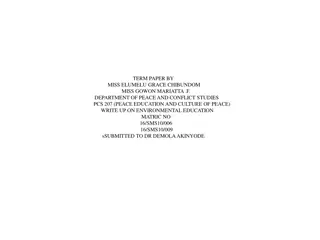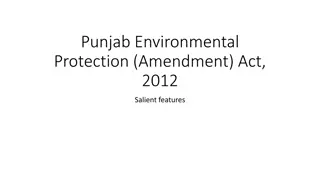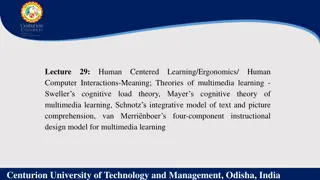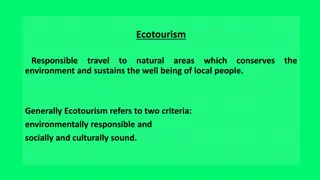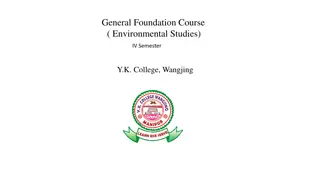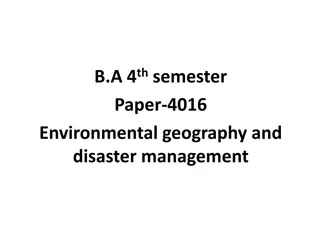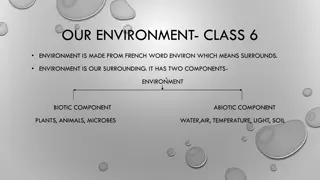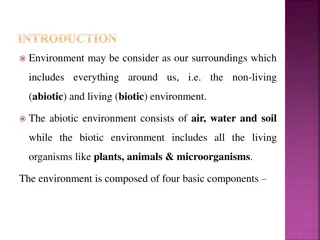Understanding Human-Environment Interaction: Environmental Determinism vs. Possibilism
Human-environment interaction is a two-way process shaping cultures and behaviors. Explore the theories of environmental determinism and possibilism, which offer contrasting views on the influence of physical conditions on human societies. Environmental determinism emphasizes the impact of the environment on shaping human behavior, while possibilism suggests that humans have the ability to adapt and shape their environment. This dynamic relationship between humans and their surroundings has significant implications for societal development and environmental governance.
- Human-Environment Interaction
- Environmental Determinism
- Possibilism
- Culture
- Environmental Governance
Download Presentation

Please find below an Image/Link to download the presentation.
The content on the website is provided AS IS for your information and personal use only. It may not be sold, licensed, or shared on other websites without obtaining consent from the author. Download presentation by click this link. If you encounter any issues during the download, it is possible that the publisher has removed the file from their server.
E N D
Presentation Transcript
Corse: B.A (Hons.) Generic Political Science IV Semester Paper: Governance: Issues and Challenges Topic: Environmental Governance
I. Human-Environment Interaction Introduction Every human endeavor is an outcome of human-environment interaction. The human being has developed a symbiotic relationship with the environment which has in turn helped them to evolve as a species. The various ecosystems and habitat adaptions have resulted in the evolution of human societies. Man stands at a very distinct level of interaction with nature among all living organisms. The term environment refers to the elements that compose the physical or conceived aspects of nature, along with their groupings in landscapes and ecosystems, with special reference to that which is considered the non-human . The term is indicative of different natural attributes which surround and actively influence human life and culture. It includes all living as well as non-living worlds. Human societies in various parts of the world have evolved in distinct ways to deal with the constraints imposed by the environment. This has led to a human-environment interaction which can explain their percipience, understanding of their nature as well as various micro-level livelihood practices.
Human-environment interaction involves the phenomenon of evolution and adaptions. The concept of human-environment interaction indicates a two-way process of interaction by which both exert various influences upon each other. Various elements in a particular eco-system have distinct roles. In a modern context, human beings have assigned themselves the most dominating role in the living world. Also the role state, development agenda and resource mobilization, and people s access to environmental wealth have emerged as some of the important concerns of human-nature interaction.
Theoretical Premises The theoretical ideals which dominated the nature of human-environment interaction. Divergent viewpoints emerged to understand and explain the relation between nature and man. During the late nineteenth and twentieth centuries, scholars, especially in the field of geographical thought, discussed various factors and mechanisms through which human societies develop a symbiotic relation with their natural surroundings. Two ideas of environmental determination and possibilism emerged which assign different set of roles and definitions to human response to their natural habitat.
Environmental Determinism Environmental determinism also known as climatic determinism or geographical determinism, espouses the view that cultures have been influenced and shaped by physical conditions, giving a secondary role to the socio-economic milieu. The proponents of this view believe that humans are strictly defined by a stimulus-response (environment-behavior) mechanism. Environmental determinism gives importance to physical environment, especially climatic conditions in deciding the psychological mind-set of individuals, which in turn defines the behavior and culture of individuals which influences the culture of the society at large. Thus, deterministic approach generally considered man as a passive agent on whom the environmental factors are acting and determining his or her attitude, decision-making processes and lifestyle.
Possibilism Very soon, the idea of environment determinism was challenged on the pretext that it provided theoretical credence to the supporters of imperialism and racism, giving rise to Euro-centric interpretation of human civilization. Also, there was no scientific data to prove many of tenets of environmental determinism. It was believed that even almost same type of physical environmental conditions cannot produce identical civilizations and cultures. Thus, a need was felt to reinterpret the approach to describe the nature of human-nature interaction. This gave rise to the possibilist school of interpretation. The main proponent of this idea was the French Geographer Vidal De La Blasche. He famously outlined that milieu externe was a partner not a slave of human activity ; insisting that nature is never more than an adviser and that the milieu interne revealed man as at once both active and passive . Thus, possibilism interprets the role of human agent in the making of socio- cultural attributes in consonance with the natural forces.
Dimensions of Human-Environmental Interaction There are many dimensions and areas of human-environment interaction in which human finds nature playing the most indispensable role. From a primitive tribal society to a highly urban and industrialized society, nature s role has always been central. The environment has been a source of major natural resources and other riches which make up for all human cultural and economic endeavours. The three most important activities, namely, agriculture, industries and tourism as primary exemplifications of human-nature interface.
Human-Nature Interaction: The Indian Perspective A Historical Perspective Elements of environment have been playing a pivotal part in the growth of Indian civilization. Ever since the advent of first agrarian settlements in Mehargarh (now in Pakistan) to the post-independence economic planning, utilization of natural resources has always impacted the nature of civilization in the subcontinent. India is an unique land, in terms of human-nature interaction, from the most primitive tribal societies of Andaman and Nicobar islands to the most urbanized/industrialized societies of the twenty-first century, environment has always moulded its role vis- -vis the needs of the society. The process of human-environment interaction in the Indian context can be understood in terms of the various ecosystem services, natural resources and biodiversity offered by the environment to regional human societies. Classical Indian texts and myths depict ecology as an integral part of man and society. Ancient treatises on state- craft such as the Arthashastra emphasizes the importance of natural resources of human beings and espouses the conservation of environment. The Ravi River was used as a line of communication with its two important resource-distribution centres, Harappa and Mohenjodaro, located on its banks. The second urbanization and the rise of Mahajanpadas in India too had a close connection with the natural habitat. Especially, the prominence of state of Magadha has been attributed to a combination of various environmental factors.
Resource Regions of India An identification and understanding of various resource-regions of India would help delineate the role of environment in the Indian context. Thus, differing socio-economic needs in the Indian context have led to the identification of various resource regions across the country, both based on agriculture and minerals. 1. The Great Plain 2. The Peninsular Plateau 3. Forests 4. The Coastal region 5. The Himalayas
The Panorama of Human-Environment Interaction 1. The Issue of Development 2. Food Security 3. Energy Hunger and Environment
II. Green Governance: Moving towards Sustainable Development Major Global Environmental Challenges: 1. Acid rain and regional-scale air pollution 2. Ozone depletion by chlorofluorocarbons (CFCs) and other industrial and agricultural chemicals 3. Global warming and climate change due to the increase in greenhouse gases in the atmosphere 4. Deforestation, especially in tropics 5. land degradation due to deforestation, erosion, compaction, salinization and other factors 6. Freshwater pollution and scarcities 7. Marine threats, including overfishing, habitat destruction, acidification and pollution 8. Threats to human health from persistent organic pollutants and heavy metals 9. Declines in biodiversity and ecosystem services through loss of species and ecosystems 10. Excessive nitrogen production and over-fertilization
Environmental Governance: International Initiatives: Concern with the international abuses of rapid industrialization gained momentum in the First World in the 1960s. There were protests against nuclear weapons and chemical pollution. The World Wildlife Fund (WWF) was founded in 1961 to preserve global biodiversity. The most significant event that happened during this period was the publication of Silent Spring by Rachel Carson (1962) which attracted the attention of the people to the impact of development on environment. She explored in her book that the increasing use of chemicals, particularly pesticides, was killing nature and wildlife. The year 1972 is a significant year in the history of Green Governance. The Limits of Growth , published in that year, argued that the post-war rate of economic expansion and population growth could not be sustained without exhaustion of global natural resources, irreparable environmental damage, and an increase in poverty and malnutrition. In the same year (1972), the United Nations Conference on Human Environment, held in Stockholm, provided the first major international opportunity for the South (Third World Nations) to highlight the links between the prevailing international economic system, environmental degradation and poverty. The conference is credited with the creation of the United Nations Environment Programme (UNDP).
Sustainable Development: An Alternative Approach to Green Governance Basic Principles of Sustainable Development: 1. Ecological sustainability 2. Social Justice 3. Inter-generation Equity and Justice
The Earth Summit: The Brundtland Report prompted the UN General Assembly, in 1989, to approve a follow-up conference in Stockholm in 20 years time to flesh out the concept of sustainable development. The 1992 UN Conference on Environment and Development (UNCED), held in Rio de Janeiro, recognized the need to couple together the two issue areas, and was a much larger and more diverse gathering than in 1972. The Earth Summit at Rio in 1992 brought out five major commitments: 1. The Rio Declaration 2. Treaties on Climate Change 3. Conservation on Biodiversity 4. Forest Principles 5. Agenda 21
Post-Earth Summit Developments: 1. Kyoto Protocol (1997) on Global Warming 2. Johannesburg Conference on Sustainable Development (2002) 3. The United Nations Climate Change Conference (2015)
Indian Perspective to Green Governance: The Forty Second Amendment Act of 1976 added two-fold provisions in the constitution: 1. It directed the state for the protection of environment 2. It cast a duty on every citizen to help in the preservation of natural environment. 3. Article 48 A of the Directive Principles lays down that the state shall endeavor to protect and improve the environment and to safeguard forest, and wildlife of the country . 4. Article 51A(g) specifically refers to the fundamental duty regarding environment. 5. The Directive Principles of State Policy in Article 47 clearly underlines the environmental duty of the State to improve public health.
The major and significantActs in environmental protection in India: 1. The Wildlife (Protection)Act, 1972 2. The Water (Prevention and Control of Pollution)Act, 1974 3. The Forest (Conservation)Act, 1980 4. TheAir (Prevention and Control of Pollution)Act, 1981 5. The Environment (Protection)Act, 1986 6. The National Environment TribunalAct, 1995 7. The National EnvironmentAppellateAuthorityAct, 1997 8. The National Environment Policy (NEP), 2006 9. The Forest RightsAct, 2006 10. The National Green Tribunal (NGT)Act, 2010
Suggested Readings: Singh, Shivani. 2016 (Ed). Governance: Issues and Challenges. New Delhi: Sage Publications. Singh, Abhay Prasad and Krishna Murari.2018. Governance: Issues and Challenges. New Delhi: Pearson Publications.


